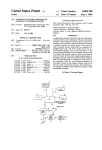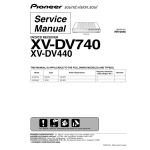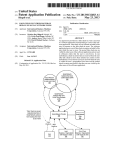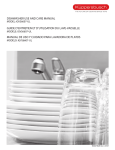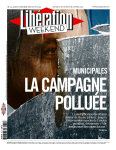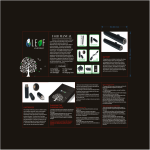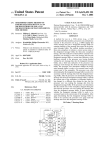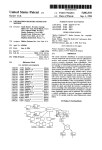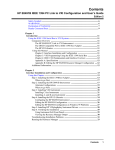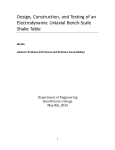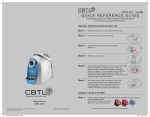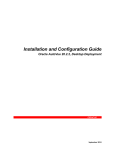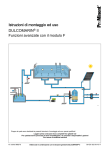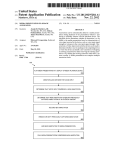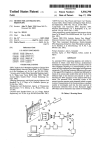Download Method of construction of hierarchically organized procedural node
Transcript
IllllllllllllllllllllllllllIlllllllllllllllllllllllllllllllllllllllllllllll US005471560A United States Patent [191 [111 Patent Number: Allard et al. [45] Date of Patent: METHOD OF CONSTRUCTION OF HIERARCHICALLY ORGANIZED Nov. 28, 1995 5,065,338 11/1991 Phillips et a1. .......................... .. 395/51 T PROCEDURAL NODE INFORMATION OTHER PUBLICATIONS STRUCTURE INCLUDING A METHOD FOR Musen et 211., “Use of a Domain Model to Drive an Inter EXTRACTING PROCEDURAL KNOWLEDGE FROM AN EXPERT, AND PROCEDURAL NODE INFORMATION STRUCTURE CONSTRUCTED THEREBY active Knowledge-Editing Tool”, Int. J. Man-Machine Studies, (1987) 26, pp. 105-121. Winston, Patrick H., Artificial Intelligence, Addison-Wesley, 1984, Chapters 2, 4 and 6. Winston, [75] Inventors: James R. Allard, St. Paul; Edward L. Patrick H., Arti?cial Intelligence, Addison-Wesley, 1984 pp. 87-93. Butler et al., “Building Knowledge-Based Systems with Procedural Languages”, IEEE Expert, Summer 1988, pp. 47-59. Cochran; Alan S. Wol?‘, both of Minneapolis, all of Minn. [73] Assigneer Honeywell In¢-.Minneap01is, Minn. Cooke et al., “A Formal Methodology for Acquiring and Representing Expert Knowledge”, Proc. IEEE, vol. 74, No. [21] Appl. No.: 197,661 _ ' [22] F?edFeb- 17’ 1994 10, O ’86 pp. 1422-1430. Patton, “Knowledge Engineering: Tapping the Experts”, Electronic Design, May 2, 1985 pp. 93-100. . . Kahn et al., “Strategies for Knowledge Acquisition”, IEEE Related U'S' Apphcatw“ Data Trans. on Patt. Anal. and Mach. lntdl., vol. PAMI-7, No. 5, [63] Continuation of Ser. No. 774,642, Oct. 11, 1991, abandoned, Sap" 1985’ pp‘ 511-522’ which is a continuation of Ser. No. 338,552, Apr. 11, 1989, Primary Examiner_Rebecca L_ Rudolph gbin9d807nezf5a:$$§ a conunuauon of Ser‘ No‘ 1’949’ Jan‘ Attorney, Agent, or Firm—Paul H. McDowall; Michael B. ’ [51] [52] 5,471,560 ’6 Int. Cl. 4 Atlass; Trevor B. Joike .................................................... .. G06F 15/20 US. Cl. ............................................... .. 395/77; 395/50 [57] Field of Search ................................ .. 395/10, 12, 50, A knowledge acquisition tool for direct use by an expert in 395/51, 75, 76, 77 the automatic creation of a knowledge base derived from the knowledge of the expert, the knowledge acquisition tool including an input device usable by the expert for providing _ References Clted 156] Us‘ PATENT DOCUMENTS ABSTRACT knowledge to the tool in response-to questions, statements and/or prompts from the tool, a display for displaying the 4,318,184 3/1982 Millett et al. ......................... .. 364/900 4,613,946 9/1936 Forman - - - - - - - - - - - - - -- 364/513 expert can interact with the tool in creating the knowledge 4,653,370 4/1987 Erma“ et a1‘ - - - - - - - - - ~- 364/513 base, and a processor connected to the input device and the 4,752,889 6/1988 Rappap‘m et a1 4,763,277 8/1988 Ashford et al. 4,816,994 3/1989 Frelllng et a1. 4 841 441 6/1989 Nixon et 31 364/513 I: 364/200 . . . ... ... knowledge, questions, statements and prompts so that the "" " 364/188 display for supplying the questions, statements and prompts . . . . .. to the display in order to extract the knowledge from the 364/900 - .... .. 364/200 4:853:873 8/1989 Tsuji et a1. 4,891,766 1/1990 Derr et al. ........................ .. 364/513 4,9l6,633 4/1990 Tychonicujch et a1. .......... .. 364/513 - . . 5 Claims, 5 Drawing Sheets /30 USER INTERFACE EXPAND KB= COMPLETE NODE= GSBAPH 0F ASK USER USER , SUBROUTINE C?gL-FEYETM SPAWN ACTlONS CONDITIONALS OTHER MENU T L MACHINE - EXECUTABLE KNOWLEDGE BASE l l ENGLISH LANGUAGE KNOWLEDGE BASE . the knowledge Provided by the exPert through use of the input device 4,967,368 10/1990 Bolling et a1. ........................ .. 364/513 AOD NODES DELETE "ones . expert in the creation of the knowledge base incorporating ‘_ TUTOR'M' K8 STRUCTURE i——J U.S. Patent Nov. 28, 1995 Sheet 1 0f 5 5,471,560 / I I I2 I4 0/‘ / _ _ 13 II /_/ 2O ’ ‘ i I MOUSE KEYBOARD T13 /./ 2| PROCESSOR 1 l l l RAM ROM VIDEO PRINTER Lll L22 123 124 125 £19- 2 /3o USER lNTERFACE APH EXPAND K8= COMPLETE NODE= H658 ADD NODES #EEPSER DELETE NODES Loop COMPLETE ggggholux'cg?ous NEXT ACTION U SER CONDITIONALS OTHER M ENU MACHINE -EXECUTAB LE KNOWLEDGE BASE Fig. 3 I -- — ENGLISH I LANGUAGE KNOWLEDGE BASE 0 F @ -— TUTORIAL KB ‘ HSTRUCTURE US. Patent Nov. 28, 1995 Sheet 3 0f 5 5,471,560 SPECIFY GENERAL KNOWLEDGE BASE T0 EXECUTE GOAL N LEVEL 1 LEVEL 2 LEVEL 3 U.S. Patent Nov. 28, 1995 Sheet 4 0f 5 5,471,560 KAT - STA RT TUTORIA L MAKE~ PML SHOW- STOC SHOW-VARIABLES CREATE‘VARIABLES / GRAPH-OPTIONS KNOWLEDGE-BASE L|ST~ COMPARATORS W"! L QUIT OR SAVE r‘ ACTION KAT-FRAME GRAPi'ER-Wl NDOW NODE-COPY TEXT ' WI NOOW TV-WINDOW US. Patent Nov. 28, 1995 Sheet 5 0f 5 5,471,560 KNOWLEDGE' BASE [FILE SYSTEM 1 \ ACTION KAT FRAME ACTION-INTERNAL UNEXPANDED- ACTION UNEXPANDED- UNEXPANDED- . UNEXPANDED- SEQUENJE ASK ANNOUNCE ASK ANNOUNCE UNEXPANDED- UNEXPANDED' SET CUSTO M UNEXPANDED CONDITIONAL SEQUENCE SET CUSTOM / VARIABLES Hg. 7 5,471,560 1 2 METHOD OF CONSTRUCTION OF HIERARCHICALLY ORGANIZED PROCEDURAL NODE INFORMATION STRUCTURE INCLUDING A NIETHOD FOR EXTRACTING PROCEDURAL KNOWLEDGE FROM AN EXPERT, AND PROCEDURAL NODE INFORMATION STRUCTURE CONSTRUCTED THEREBY heretofore been labor-intensive and time consuming, auto mated knowledge acquisition can be cost e?’ective since it reduces the level of effort needed in the knowledge acqui sition and knowledge base creation tasks. An automated knowledge acquisition tool allows the expert to progress at his or her own speed and at times convenient to the expert, unharnpered by aknowledge engineer who may be relatively unfamiliar with the ?eld. SUMMARY OF THE INVENTION This application is a continuation of application Ser. No. 07/774,642, ?led Oct. 11, 1991, now abandoned, which is a Accordingly, the knowledge acquisition tool of the continuation of application Ser. No. 07/338,552, ?led Apr. 11, 1989, now abandoned, which is a continuation of appli cation Ser. No. 07/001,949, ?led Jan. 9, 1987, now aban 15 doned. present invention interviews an expert to automatically create a knowledge base derived from the knowledge of the expert and includes an input device, such as a keyboard and/or mouse, usable by the expert for providing knowledge in response to questions, statements and prompts from the tool, a display such as a CRT screen for displaying the BACKGROUND OF THE INVENTION The present invention relates to a knowledge acquisition tool which automatically interviews an expert and extracts the knowledge of the expert for the creation of a machine 20 knowledge, questions, statements and prompts so that the expert can interact with the tool in creating the knowledge base, and a processor connected to the input device and the display for supplying the questions, statements and prompts executable knowledge base. Expert systems are being created today to allow the to the display in order to extract the knowledge from the expert in the creation of the knowledge base incorporating ordinary technician to operate at the level of an expert. Such the infonnation provided by the expert through use of the expert systems are useful in a wide variety of ?elds such as 25 input device. medicine, building maintenance, automobile repair and the like. Even though such ?elds vary widely, expert systems BRIEF DESCRIPTION OF THE DRAWINGS which are useful in these ?elds have one thing in common, These and other features and advantages will become the ability to allow anyone practicing in the ?eld to operate with the e?iciency and knowledge of the expert. 30 more apparent from a detailed consideration of the invention An expert system guides the end user, who as mentioned may be an ordinary technician, through a problem solving exercise. The system provides information to the end user permitting the user to make intelligent choices among a 35 when taken in conjunction with the drawings in which: FIG. 1 is an overview of the knowledge acquisition tool according to the present invention; FIG. 2 is a block diagram showing in more detail the number of possible alternative actions and to provide infor knowledge acquisition tool according to the present inven mation to the system in order to elaborate those actions. For tion; example, in the automobile repair ?eld, the end user (mechanic) may be asked by the system to ?rst choose among the major components of the automobile (engine, edge acquisition tool according to the present invention; FIG. 4 shows the knowledge acquisition tool display FIG. 3 shows an overview of the features of the knowl drive train, etc.) on which service is to be conducted. The system then progressively narrows the possible choices in frame which is displayed on the display screen of the tool and provides the main interface between the tool and the order to focus upon the area to be serviced or the problem expert; to be solved. In this process, the system may ask for input from the end user in order to present to the end user the most 45 probable selection of choices or actions. Thus, the system may ask the mechanic whether the engine has 4, 6 or 8 cylinders, whether each cylinder is getting a spark, what the compression is in each cylinder, etc. In creating an expert system, a lmowledge engineer plays the active role of acquiring domain knowledge from an expert and transferring this knowledge to a knowledge base. The knowledge engineer is the creator of the knowledge base and the domain expert is the expert in the domain of interest whose knowledge is to be extracted and used to create the knowledge base. This knowledge base is then used FIG. 5 shows a fundamental functional ?ow chart of the knowledge acquisition tool; FIGS. 6 and 7 show a module dependency diagram of the knowledge acquisition tool; and, FIG. 8 shows a tree illustrative of the hierarchical expan 50 sion of action items by the expert in response to the knowledge acquisition tool. DETAILED DESCRIPTION The knowledge acquisition tool according to the present 55 as the foundation of the expert system to allow the end user to function at the level of the expert. The acquisition of invention can be implemented by way of a computer such as the computer 10 shown in FIG. 1. Computer 10 has a keyboard 11 for interacting with the inquiries and/or state ments displayed on display screen 12 so that the expert, from whom knowledge is to be extracted and used in the creation the creation of the knowledge base are time-consuming and 60 of the knowledge base, can interact with the tool. Also di?icult tasks. provided is a mouse 13 which the expert can use to move a knowledge from an expert by the knowledge engineer and The present invention facilitates these time-consuming cursor in the form of a runner about the display screen 12 and to click onto various menu items shown in the menus tasks by automating the knowledge acquisition and knowl edge base creation functions. Such an automated knowledge acquisition tool has many advantages. For example, the use of automated knowledge extraction provides consistency in the interview techniques. Because knowledge extraction has 65 which are projected onto display screen 12. The knowledge acquisition tool of the present invention will be referred to hereinbelow and in the attached Appendices variously as KAT, Fat KAT or KLAMSHELL. 5,471,560 3 4 KAT frame 14 is shown on display screen 12 in FIG. 1. Frame 14 is used to present the various menus and graphics can specify a plurality of further subactions or nodes such as be discussed in more detail hereinbelow. D, E and F at level 2. From D, in turn, further subactions G and H at level 3 can be speci?ed. The hierarchical procedure of the present invention requires the expert to expand a branch along the tree (such as A-B-D-G) before any other branches (such as A~B-D-H) depending from it are The block diagram of the computer shown in FIG. 1 is shown in FIG. 2 and comprises processor 20 connected over bus 21 to random access memory 22, read only memory 23, expanded. Thus, after action A is expanded into subactions B and C, the ?rst subaction, B, is expanded into subactions D, E and F the ?rst of which, D, which is in turn expanded video controller 24 which controls what is being displayed upon display screen 12, and printer 25 which can make hard into subactions G and H before any other action or subaction can be expanded. Once the branches A-B-D-G and A-B-D-H to the expert user during the process of extracting the expert’s knowledge for inclusion into the knowledge base produced by tool 10. The arrangement of this frame 14 will and permanent copies of any of the menu or information are fully expanded in that order, and assuming that subac display items which are displayed upon display screen 12. For providing the interface between the expert and the knowledge acquisition tool are the keyboard 11 and mouse tions G and H need no further expansion, then the next 13 as shown in FIG. 1. 15 unexpanded action at level 2, i.e. action E, can be expanded into its subactions I and J. Action C cannot be expanded until all level 2 actions emanating from action B are expanded. Then action C may be expanded. In the example of FIG. 8, hierarchical expansion of the action tree requires that the branches be expanded in the following order: A-B-D-G; then FIG. 3 shows an overview of the knowledge acquisition tool system in terms of the manner in which the knowledge acquisition tool 10 interacts with the expert in the extraction of the expert’s knowledge for the creation of the knowledge base. The expert, represented by block 30 in FIG. 3, is guided through the creation and editing of the knowledge A-B-D-H; then A-B-E-I; A-B-E-J; A-B-F-K; A-B-F-L; A-C M; A-C-N. In order to conduct such an interview, the user interface base in a highly structured manner using primarily a depth reasoning. Accordingly, the knowledge acquisition tool of the knowledge acquisition tool allows the expert to add or delete nodes (i.e. actions) and complete the next action as shown in FIG. 3. In order to complete the next action, several functions are available to the expert. The expert may’ create a question (ask user) which solicits information from interviews in a top-down manner by asking the expert to successively re?ne his or her knowledge. The expert is ?rst building air conditioning equipment, for example, the end ?rst questioning method. That is, the knowledge acquisition tool of the present invention relies upon a direct interview strategy of guiding the expert along hierarchical lines of the end user. In an expert system for the maintenance of asked to identify high-level procedures, which may be user may be asked to provide the temperature of the chilled water. Additionally, the expert may tell the user to perform a particular task or function. Thus, in the chiller maintenance tool of the example, the expert may direct the end user to “check the refrigerant” or “?x the heat controller”. The expert may create loops such as requiring the end user to referred to as nodes or actions, and which will later be decomposed into sub-procedures which in turn may be further decomposed into subordinate procedures, and so on. This interview process proceeds in a depth-?rst manner. That is, from the expert’s perspective, an individual line of reasoning is followed to a logical conclusion before other lines are pursued. This hierarchical expansion or interviewing process can best be explained by referring to FIG. 8. The process can be referred to as a bottom-most, left-?rst expansion procedure perform a task or a series of tasks a number of times until completion or perform a series of alternative maintenance tasks until a component has been ?xed. Subroutines may be created by the expert which can be accessed by the expert system whenever a predetemrined set of conditions exist. 40 The expert can spawn actions, i.e. specify a set of new if the tree is constructed in a vertical manner or as a actions. The expert can also establish conditionals such as top-most, right-most procedure if the tree is constructed in “only do B if A is true.” a horizontal manner, but both or either is used to de?ne the hierarchical expansion or interviewing process of the present invention. This hierarchical approach requires a line of reasoning to be fully expanded before other lines of reason ing can be expanded. FIG. 8 shows the creation of a 45 The knowledge acquisition tool has several options which will assist the expert in constructing the knowledge base. These options can include an on line Tutorial which allows the expert to learn more about the knowledge acquisition tool without referring to a separate user’s manual, lists of direction. A distinction is made between the speci?cation of Variables for allowing the expert to inspect the names and nodes and their later expansion into completed lines of 50 associated values of variables which he or she has declared horizontal tree although the tree can be constructed in any reasoning. Experts ?rst specify a set of goals and subgoals, and begin to complete or expand each bottom-most subgoal only when no further subgoals will be generated along any particular line of reasoning. This method of interviewing leads to two bene?ts: ?rst, a line of reasoning is always in the construction of the knowledge base, the Knowledge Base Structure which presents to the expert a list of all the actions he or she has created in the knowledge base and a 55 followed to its logical conclusion; second, intermediate graph of the knowledge base, such as that shown in FIG. 8. Once all of the relevant knowledge has been extracted from the expert, and the knowledge base has been created, the knowledge acquisition tool can write the knowledge base goals speci?ed but not yet expanded serve as reminders to the expert of what remains to be completed. in a machine-executable code for use by an end user. In FIG. 8, the expert may have de?ned his knowledge According to the present invention, the knowledge acquisi base in terms of A. Knowledge base A can be broken down by the expert into two basic parts or actions at level 1. Each part can be further expanded at level 2 and any of these parts may be further expanded at level 3. The hierarchical expan sion of actions requires the expert to pursue each line of 60 reasoning completely before the expert pursues other lines of reasoning. As shown in FIG. 8, for example, knowledge 65 base A has subactions or nodes B and C. From B, the expert tion tool writes the knowledge base in PML which is a knowledge-engineering language developed by Honeywell Inc., although it is designed to be able to write the knowl edge base in any language. At the completion of a knowl edge acquisition session with the knowledge acquisition tool, the expert is presented with an english language description of the knowledge base which has just been created. This description can be read by an expert who is 5,471,560 6 5 unfamiliar with programming languages. collections of code in the system and show which pieces of FIG. 4 shows the KAT (or KLAM Shell) frame which the expert sees on the display screen of the knowledge acqui sition tool. Frame 40 is comprised of a plurality of windows. Window 41 will show the graph of the entire knowledge base being created by the expert. As can be seen from FIG. 4, the graph is in the form of a horizontal tree which branches from the most general actions or nodes de?ned by the expert to progressively more particularized subactions. code use which other pieces. Code grouped in a function is represented as an oval around the name of the function, and Window 42 may display a logo and/or other markings which identify the knowledge acquisition tool. Window 43 shows The knowledge acquisition tool can then be started which some of the options which are available to the expert. For 4, to be displayed as the system’ s input/output window. The function KAT-START is called as the acquisition tool’s top level function. This function will bind all system global example, the expert can list the created variables, graph the actions, save any of the expert’ s inputs, ?nd actions, execute the knowledge base being constructed to con?rm its accu code grouped as methods which operate on data types is represented as a box, with a double top bar, around the name of the data type. Arrows go from the using code to the used code. The present system can be loaded into any one of the Symbolics computers, such as computer 10 shown in FIG. 1. causes an instance of the frame, such as that shown in FIG. 15 variables de?rrining streams, bind the package variable, bind the knowledge base variable, and set up handlers for system racy, create variables, see a tutorial which can be similar to an owner’s or user’s manual, can list the created actions. other control device attached to the knowledge acquisition errors. The stream variable should be bound to a background window which is used only when there is an error to report to the user. If an error is caught, the background window will be exposed, a message printed on it which describes what has happened to the user in terms that the user can under stand, and the user will be offered a chance to attempt to save tool. The expert can also use the mouse cursor in window 43 the knowledge base. Then, the system will reset its process in order to select any of the options available to the expert and start itself over. Window 44 shows that part of the graph as displayed in window 41 selected by runner 45. Window 44 shows an exploded view of that part of the graph bounded by runner 45 the position of which can be controlled by a mouse or or in window 46 in order to make any selections o?°erred 25 there. For example, if the expert selects the option “list actions”, all of the nodes or actions which the expert has created will be shown in window 44. If the expert selects the option “graph options” as shown in window 43, then win dow 44 will present the options in graphical form such as 30 that shown in FIG. 4. As can be seen, these actions/nodes are shown in horizontal fashion rather than vertical fashion. For convenience, however, “hierarchical manner” is used to describe the method used in the present invention of expand ing unexpanded actions by pursuing one line of reasoning or branch completely to its end before expanding dependent Besides setting up these global variables and establishing an error handler, it is KAT-START’s job to present the title page, offer the user a chance to see the tutorial, and call the function MAKE—PML. MAKE-PML is de?ned in Appendix A, available in the patented ?le, and has the job of calling GET-KNOWL EDGE-BASE, passing the returned knowledge base object to the function CONTROL-LOOP, and then sending the knowledge base object over to WRITE-KNOWLEDGE BASE and returning. GET-KNOWLEDGE-BASE queries 35 the user for the name of the new knowledge base or the name saved, variables created, actions found, etc. by selecting the appropriate option as displayed in window 43. of a ?le containing a saved knowledge base which is to be edited, calls make-instance with this information and returns the created knowledge base. At this point, the user interface screens for both the title page and the GET-KNOWLEDGE BASE queries can be simple text screens on which text Finally, window 46 shows a window in which the tool provides information to the expert in order to aid him in together with a possible logo and one line queries are presented. WRITE-KNOWLEDGE-BASE will ask the branches whether a vertical approach or a horizontal approach is taken. Variables can be listed, information providing his expert knowledge to the knowledge base and in which he is guided by a series of questions, statements and prompts into making choices or providing knowledge which aids the knowledge acquisition process. user via one line queries about the ?le name under which to 45 FIG. 5 shows a functional ?ow chart of the knowledge acquisition process. When the knowledge aquisition tool is invoked, the tool ?rst directs the expert to specify the general goals (actions). The ?rst unexpanded goal is 50 write out the knowledge base. Upon entry to the CONTROL-LOOP function, the KAT or KLAM frame (the main window instance) is placed into the KAT or KLAM editor con?guration and is arranged as shown in FIG. 4. While editing the knowledge base, the expert will always be presented with a frame similar to that shown in FIG. 4. Window 44 shows the detail of the expanded and a procedure is de?ned to execute that goal. This process is repeated until all goals, at all levels, are expanded and procedures are de?ned for them in a hierar hierarchical graphic display of the network of actions exist ing in the knowledge base and being edited at the time. The are no more unexpanded goals, the knowledge base is written. The module dependency diagrams shown in FIGS. 6 and 7 taken together with Appendix A available in the patented ?le, which is the functional speci?cation at the source level (in LISP) de?ning the modules and statements useful in currently visible in window 44. The portion of the graph being shown in window 44 may be moved with mouse 13 by clicking on the graph and “pulling” a point to the center of the display, or by clicking on the overview window 41 and positioning the runner over the part of the overview graph to be displayed in more detail. At any time an option may be clicked on in the options window 43. Similarly, any of the overview window 41 shows a scaled down version of the chical manner such as the one shown in FIG. 8. When there 55 entire graph with a runner around the portion of the graph making the present invention describe the knowledge acqui action nodes, such as A-P shown in FIG. 4, can be clicked sition tool and process in more detail. Appendix A also includes de?nitions of the screens which are presented by the tool to the expert during the knowledge acquisition process. The diagrams of FIGS. 6 and 7 represent the basic on and several display and editing options for this action will 65 be presented. All textual interaction with the expert will take place in the expert I/O section which is window 46 shown in FIG. 4. 5,471,560 7 8 Depending on the type of interaction which needs to take place, window 46 can be in one of three di?erent basic forms. The simplest form is a text window. This con?gura tion will be used for small menus which ?t into the window and for one line expert queries. The second con?guration breaks up window 46 into three parts. The ?rst part is a bar at the top of window 46 for displaying a message to the user. The second larger part, which is in the middle of window 46, is a scroll window. The third part at the bottom of window 46 is a small text window for displaying a prompt. This second form will be used for displaying long menus, for edge base will return a ?ag to that effect when sent NEXT ACTION-TO-EDIT. This will cause the CONTROL-LOOP to print a message asking if the user wishes to ?nish, giving him or her the chance to click on actions in the graph to edit them. When the user does choose to quit, CONTROL-LOOP will return the knowledge base object, WRITE-KNOWL EDGE-BASE will write it out to a ?le, and KAT-START will reinvoke itself, starting over again at the beginning title l0 showing accumulations of potentially long lists (such as the lists of subactions a user may enter for a sequence) and for other similar situations where a large number of items need to be presented to the expert. The third form breaks window 15 46 into basically two parts, a top and a bottom part. The top part is a small text window for displaying a message and the bottom part can be used for entering complete text answers. This third form can be used for entering messages for announce actions, and for editing the PML source of custom actions. As shown in FIG. 6, after picking a knowledge base the expert will interact with the display shown in the KAT frame. The expert will always be presented with a viable editing option in window 46 but a desired action can always 25 be clicked on in the graph for directly editing it. The graph will always show the current state of the knowledge base and any option displayed in window 43 may be used at anytime by simply clicking on it. The knowledge base, speci?cally an action within the knowledge base to be expanded (further re?ned), is shown in the KAT frame. In the main loop of the function CON 30 page. Pages A-26 through A-38 de?ne the various screens displayed in the KAT frame. These screens provide the main interface between the expert whose knowledge is to be extracted by the present knowledge acquisition tool and the tool itself. These screens have been replicated in Appendix B, available in the patent ?le, which is an example of the screens viewed by the expert during the expert’s creation of the expert knowledge base. The example shown in Appendix B, available in the patented ?le, is a purely hypothetical example and is included merely for explanatory purposes. When the system is turned on, the screen shown on page B-l, which is a screen display relevant to the particular system in which the knowledge acquisition tool according to the present invention is used is presented to the expert. As shown on B-2, the expert is asked to log on and the screen display shown in B-3 introduces the user to the identity of the knowledge acquisition tool. This screen also o?Eers the expert user the opportunity to view the tutorial or to directly begin establishing a new knowledge base or editing a knowledge base currently under construction. Assuming that the editing function is chosen by pressing RETURN, the expert user is presented the screen display TROL-LOOP, the function sends to the knowledge base the NEXT-ACTION-TO-EDIT message. This message will shown on page B-4. The action PM-ROOT merely serves as cause the knowledge base to return the next unexpanded 35 action to be expanded in the hierarchical manner as de?ned above. FIG. 7 expands FIG. 6 in order to show in more detail how the starting point for the graph which is to be created by the expert, i.e. the root of the tree which will be created. The expert is asked to enter a list of sub-actions for this root action. At this point, the expert will de?ne the most general actions (the highest level categories in the break down of this knowlege). In the example shown, the user types in two an unexpanded action is expanded. Any unexpanded action changes itself into one of several ?avors by operation of the actions as shown on page B-S. After entering the last action expert who is presented with a menu of ?avors from which to select. These ?avors are unexpanded-sequence, unex name, RETURN is pressed and the expert is presented the panded-conditional, the choice of expanding the ?rst action (the ?rst unexpanded unexpanded-ask, screen as shown on page B-6. This screen offers the expert unexpanded-an nounce, unexpanded-set, and unexpanded-custom. In expanding an action, the expert is presented with the choice of expanding any action into one of the following ?avors: 45 action in the tool’s hierarchical manner of expansion), adding another action to the list or deleting an action. As shown on page B-7, the expert has selected choice 1, the expansion of the ?rst action. It should be noted that in the ask, armounce, sequence, set, or custom. The ask ?avor requires the end user of the expert system to get information hierarchical development of the knowledge base, as and supply it to the system. The announce ?avor imparts 50 described with respect to FIG. 7, the expert is always asked information to the end user. The sequence ?avor generates a to expand a branch of the tree before expanding any list of subactions which the end user is to do. These branches depending from it. subactions may be in a sequence or each subaction may be Upon selecting choice 1 and selecting the Redisplay paired with a conditional test. The set ?avor requires the end option, the expert is presented the screen shown on page B-8. At this point, the system expands the graph as shown in the middle window of the frame and as shown in upper left hand comer of the frame. Here, the expert is asked to de?ne user to set a variable. The custom ?avor allows the expert who is creating the knowledge base to de?ne a ?avor not otherwise o?erred. There are several options which will abort changes cur rently being made to an action. They are (l) choosing another action to edit by clicking on it in the graph, (2) choosing to quit, or (3) hitting the abort key to speci?cally the ?avor of the unexpanded action. That is, he will assign the unexpanded action one of the following ?avors: unex 60 panded-ask which is choice 1; unexpanded-announce which is choice 2; unexpanded-sequence which is either choice 3 abort current changes. Whenever an action is aborted, con or choice 4 depending on whether the sequence is a true trol is passed back to the CONTROL-LOOP function via the sequence or where each item in the sequence is paired with LISP THROW mechanism. When such an abort takes place, a conditional; unexpanded-set which is included as part of the knowledge base is left at the state it was in immediately 65 choice 5; or, unexpanded-custom which is choice 6. Choice before initiation of the current action change or edit. 7 allows the expert to abort this editing function. As shown When an action network has been completed, the knowl on page B-8, the expert has used the runner controlled by the 5,471,560 9 10 mouse to select choice 1. The expert clicks on to choice 1 and is then presented with the screen shown on page B-9 with the conditional. This process is shown on pages B-17 through B~22. Every time the expert presses RETURN, a new conditional is presented to the expert. It should be noted that pages 13-17 through B-22 show the same screen display. requiring the expert to expand the unexpanded ?avor UNEXPAND-ASK. In this case, the expert expands this unexpanded ?avor by typing into the scroll window, which is the bottom window of the frame, the question “What kind of food do you want to eat?” which is to be asked of the end user. This question will then be presented to the end user during his or her use of the expert system incorporating the knowledge base which is being created in Appendix B. The purpose of this particular knowledge base is to aid the end user in making such a selection of a restaurant based upon the expert’s knowledge Thus, the question entered by the expert, although it is not viewed by the expert in any of the graphs, will be presented to the end user when he or she is using this knowledge base in order to select a restaurant. As shown in the screen on page B-10, the expert is then 15 This screen display is shown in multiple pages to show the process that the expert goes through in establishing the actions for each automatically generated conditional. When the ?nal condition is presented to the expert and the expert enters the action item in response to this condition and presses RETURN, the expert is presented With the display on page B-23 at which time the expert is led through the expansion of each of the action items which have just been established. Page B-23 shows that the expert has clicked on to the option “redisplay”. Page B-24 shows the frame after the “redisplay” function. Following the action “RECOMMEND-A-RESTAURAN’I“, there are three sub actions de?ning the three restaurants to which the end user eat?”. After the expert presses RETURN, the expert is then is directed depending upon what food type he selects. Page B-25 shows that the expert has selected item 1, completing (expanding) the ?rst subaction. The expert is then presented required as shown on page B-11 to de?ne the variable as one with the menu shown on page Bo26 which indicates that the which is continuous (involving a range), which is discrete expert has selected item 2, i.e. the announce ?avor. Upon pressing RETURN, the expert is then presented the screen asked to establish a variable name for the responses of the end user to the question “What kind of food do you want to (involving one or more distinct variables), or which is a on page 13-27 which requires the expert to set up the string (involving a set of text characters). As shown on page B-11, the expert has selected item 2 and, upon pressing RETURN, the screen shown in page B12 is displayed. This 25 screen display is for the information of the expert only. The expert is informed that he or she should enter the items to be displayed to the end user of the knowledge base and that, upon entering the last menu item, the expert should press RETURN in order to continue. Upon pressing any key, the expert is presented with the screen shown on page B-13 and in which he must enter the items to be displayed to the end user. As shown, the items have been entered. Thus, when the end user is presented the question “What kind of food do you want to eat?”, the end user will also be presented with a selection of food types to be selected. When the expert has ing pages B-28 through B-33, the expert is likewise led informs the expert that there are no more unexpanded actions in the knowledge base and asks the expert to use the mouse in order to click on an option if the expert wishes to 35 responds in the a?irrnative. Pages B-38 and B-39 relate to writing the knowledge base and pages B-40 and B-41 relate to logout. As can be seen, the knowledge acquisition tool of the present invention automatically interviews a domain expert, Having completely expanded the ?rst action branch “SELECT-FOOD-TYPE”, the knowledge acquisition tool then guides the expert through expansion of the action “RECOMMEND-A-RESTAURANT”. Accordingly, the “RECOMMEND-A-RESTAURANT”, to keep editing. As shown on page B-37, the expert chooses to save the knowledge base and is queried concerning the selection of this option (on page 13-38) to make certain that he or she wishes to save the knowledge base. The expert presses RETURN and is presented with the screen shown on page B-14. action selects mexican food. Thus, the expert de?nes the ?avor of the action “GO-TO-EL TORITOS”. As shown in the remain through the de?ning of the ?avors for the other subactions. As shown on page B-34, the knowledge acquisition tool completed describing the variable “food type”, the expert expert is again presented with three choices, to expand the information to be announced to the end user if the end user 45 add that is an expert whose knowledge is to be extracted and is to be used by an end user in the performance of a function at the expert’s level of expertise. The tool leads the expert through the creation of a knowledge base which incorporates the expert’s knowledge in the form of actions and subactions another action to the list or to delete an action. As shown, the expert has used the mouse to click on to the ?rst choice and is then presented with the screen shown on page B-lS. As to be performed by an end user based upon observances that are made by the end user which form the end user’s input to indicated, the expert has selected choice 4 from this menu 50 an expert system. such that the knowledge acquisition tool of the present The embodiments of the invention in which an exclusive invention will guide the expert into establishing a list of property or right is claimed are de?ned as follows: subactions each of which is paired with a conditional test. 1. A method for eliciting procedural knowledge from an expert for constructing an expert system said method being Upon clicking on to item 4, the expert, as shown on page B-16, will be presented with information and then asked to 55 executable on a computer having an associated display device which results in the generation and display, in order, choose whether the conditional test/sub-action pairs are to pairs and is presented with the screen display on page B-17. In this case, the knowledge acquisition tool leads the expert to the expert of a representation of an organized procedural information structure having properly ordered nodes, each of said nodes de?ning a goal, each said goal a parent goal to either a set of daughter goals which when completed effec through the automatic generation of the conditional pairs by tuate said parent goal, or alternatively, a set of procedures for presenting to the user the conditional statements based upon eifectuating said parent goal, wherein each said procedure the variables previously established and requiring the expert consists of instructions and questions to be put to said users in order to lead said user to achieve said goals, said method be generated manually or automatically. The expert has selected automatic generation of conditional tests/sub-action to de?ne the action if the conditional is true. As shown on page B-18, the expert has entered in the action item which is paired with the ?rst conditional. Each conditional is presented to the expert and he is asked to pair an action item 65 comprising the following steps wherein the requesting of said knowledge from said experts and his responses thereto are via said display device: 5,471,560 11 12 A. requesting said expert to generally categorize said but only in an allowable order as speci?ed in the construc procedural knowledge to de?ne a current reference goal tion of said structure, constructed by the process of eliciting procedural knowledge from an expert for constructing an expert system said method being executable on a computer having an associated display device which results in the generation and display, in order, to the expert of a repre sentation of an organized procedural information structure which is initially a root goal which a user would want to achieve; B. requesting said expert to specify in a preferred order all goals which are daughters of the current reference goal, said daughter goals to be achieved before achieving their parent thereof, i.e., the current reference goal, which preferred order will determine the order to which having properly ordered nodes, each of said nodes de?ning a goal, each said goal a parent goal to either a set of daughter goals which when completed e?ectuate said parent goal or alternatively, a set of procedures for e?’ectuating said parent goal, wherein each said procedure consists of instructions said user may be displayed any of said goals or nodes, and also requesting said expert to specify the condi tional relationships, if any, between any daughter goals and questions to be put to said users in order to lead said user and the current reference goal, each of said conditional to achieve said goals, said method comprising the following steps wherein the requesting of said knowledge from said relationships determining whether particular proce dures will be displayed to the user, and each of said conditional relationships being designated by the experts and his responses thereto are via said display device: expert as relative to information already made available to the expert system by said expert or by a user in response to procedures at run time, and in the absence A. requesting said expert to generally categorize said of any said daughter goals proceeding to step D; to achieve; B. requesting said expert to specify in a preferred order all goals which are daughters of the current reference goal, procedural knowledge to de?ne a current reference goal which is initially a root goal which a user would want C. designating on said display means and in accordance with said preferred order the new current reference goal said daughter goals to be achieved before achieving their parent thereof, i.e., the current reference goal, and returning to step B; D. requesting said expert to specify procedures and to complete said current reference goal; E. designating on said display means the parent goal of 25 said current reference goal as the current reference goal and, if there is at least a remaining one of said goals branching therefrom, then designating the next one of said remaining one of said goals in accordance with said preferred order as the current reference goal and 30 and also requesting said expert to specify the condi tional relationships, if any, between any daughter goals and the current reference goal, each of said conditional relationships determining whether particular proce dures will be displayed to the user, and each of said conditional relationships being designated by the returning to step B; F. stopping if said current reference goal is said root goal but otherwise returning to step E. 2. A method according to claim 1 wherein in step E said which preferred order will determine the order to which said user may be displayed any of said goals or nodes, 35 expert as relative to information already made available to the expert system by said expert or by a user in response to procedures at run time, and in the absence of any said daughter goals proceeding to step D; expert is ?rst given the options of adding a descendent goal C. designating on said display means and in accordance with said preferred order the new current reference goal to said parent goal or removing a descendent goal from said parent goal. 3. A method according to claim 1 wherein in said step D involves giving or getting information to or from the end user in a predetermined order as speci?ed in said step B thereof. 4. A method as set forth in claim 1 wherein in Step D said 40 expert may specify the conditional relationship, if any, between the current reference goal and its parent, and the conditional relationship, if any, between the procedures and any goal. 5. A digital computer system operable as an expert system 45 which employs a procedural node information structure having a set of nodes hierarchically arranged and condition 50 and returning to step B; D. requesting said expert to specify procedures and to complete said current reference goal; E. designating on said display means the parent goal of said current reference goal as the current reference goal and, if there is at least a remaining one of said goals branching therefrom, then designating the next one of said remaining one of said goals in accordance with said preferred order as the current reference goal and returning to step B; F. stopping if said current reference goal is said root goal but otherwise returning to step E. ally dependent such that display to a user exposes to the user each procedure required for the attainment of the user’ s goal, *****












